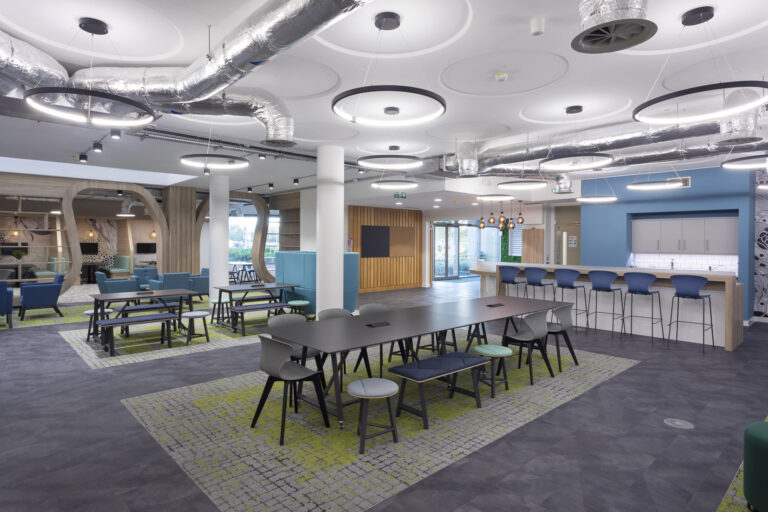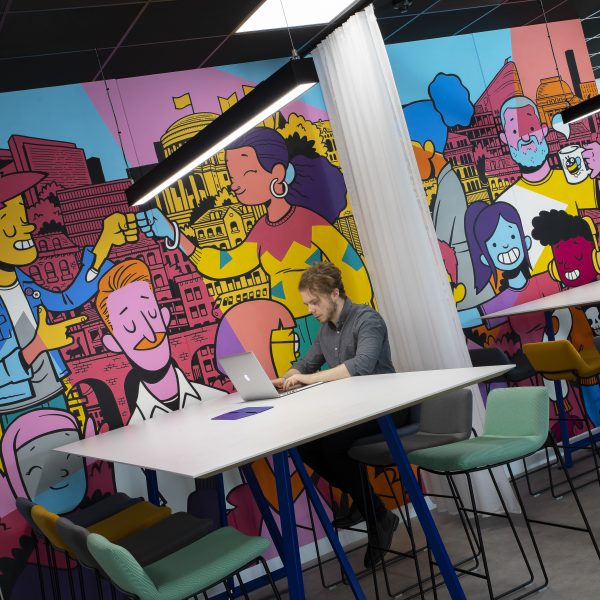
The Wheels Of Workplace Change – Is Hub And Spoke The Answer?
Date
20 April 2021
Read length
5 min
Just over a year ago – the world wondered if the office was dead and permanent homeworking would be the pandemic’s legacy. Now, with 12 months of remote working under our collective belts and a clear desire among employees to return to the workplace for some of the working week – we have turned our attentions to how the office must respond.
The hub and spoke office model is one concept gaining traction as it offers greater flexibility and reflects a new set of behaviours – but what does it really mean for businesses and their FM teams? And how does it impact ergonomics?
Here, Ann Clarke, Director of The Future Workplace explains:
“Hub and spoke describes the idea of having one primary central or head office, typically in a city centre – with smaller satellite offices or flexible spaces in secondary locations which are closer to where employees live.
Intended to offer the best of both worlds it means that employees don’t have to commute to a city centre space and instead can access smaller localised workspaces for the collaboration and community that homeworking doesn’t offer. With fewer people commuting every day, large expensive head offices can be reimagined as dynamic brands hubs – all while occupying smaller footprints and realising cost savings.
The pandemic is the biggest driver of this model and it serves to highlight the changing dynamics of how and where work is done. In turn, it presents a compelling opportunity for employers to look at the role of the workplace with fresh eyes – a process that starts with understanding how our relationship with the office has been changing for some time.
Even before lockdown there was a significant downturn in peak desk occupation and an increase overall in empty desks – just 46% of desks were unoccupied in 2019/20. Interestingly average use of meeting rooms was only 35% and collaboration spaces recorded a similarly dismal occupancy of 16% overall. Despite the drive for purposeful co-worker collaboration of recent years, the settings provided by many organisations have not been supporting staff optimally. They have been missing the mark.
So if workplaces weren’t supporting how work was done before the pandemic – they most definitely will not when our new-found desire for hybrid working plays out. It’s against this backdrop that workplace reinvention and the hub and spoke model in particular has real appeal – but in doing so, there are six primary ergonomic considerations to address:
1. Needs and motivations
Organisations must understand what their people need to thrive and what this requires of property and environment.
Workplace and employee needs analysis can help to identify the right geographic locations, buildings and workplace amenities for both the hub and the spokes. After a prolonged period away from the workplace this is particularly useful as remote working has changed processes, behaviours and what we’ll need when we do come together.
For example – even when there’s a meeting in the office, it’s likely there will always be some remote participants. This means large board rooms have much less relevance. Instead, smaller meeting pods improve the experience for physical attendees, and integrated tech and collaboration tools make it easy for remote attendees to participate fully and have parity of experience. This will need to take into account mixed presence collaboration, lighting, reducing strobing patterns, daylight control, proximity to screen and screen size, acoustics, voice capture and amplification.
At a more strategic level, businesses need to reflect on these needs and be clear about the role and purpose of both hub and spoke spaces. Are the spoke offices for meetings, head-down working or both? And what will be at the hub (facilities or experiences) that would make people want to go there?
2. Experiences
The universal acceptance that many jobs can be carried out at home requires the office to take on a new role and offer what remote working cannot – namely positive experiences rich in employers’ brand values, collaboration, community and learning.
From an ergonomic point of view this means boardroom spaces and desk-covered floors have less relevance, as our data shows, in favour of more variety and bookable work spaces, tech-enabled collaboration hubs, learning lounges and on site cafes. It also requires an understanding of demand for these spaces and the sort of tasks that will be undertaken.
Perhaps the hub’s role is as a ‘university’ – so it becomes a beacon for knowledge and learning experiences, or it is ‘project HQ’ where the focus is on collaborative tasks and team experiences.
The ability to shape positive experiences will, in part, be borne out of the needs and motivations analysis and will require the input of the senior management team – as this is more than an opportunity to redesign the workplace, but to revisit organisational ethos and convey employer brand values.
3. Homogeneity
The success of the hub and spoke model is determined by the quality of the employee experience – and perhaps more importantly the homogeneity of experience across locations. In practical terms this means ensuring that employees always have ‘brilliant basics’ and use the same process to sign in, log-in, access printers and use collaboration tools wherever they are – whether it’s the hub, a spoke or at home. This need for remarkable consistency should also include the look and feel of the design to the quality of the coffee and be supported with employee guides to ‘sell’ the experience.
4. Technology
Technology is integral to the hub and spoke model as it enables employees to move freely between spaces without compromising productivity or connectivity. As such investment in technology needs to include infrastructure as well as tools – this will help FMs to manage the workplace as an asset and demand for different resources, as well as fulfil some duty of care responsibilities, particularly in relation to where employees are.
On a day to day level, this requires ‘plug and play’ capability in all locations, with access to power, connectivity and collaboration tools as well as single platform workplace booking system to ensure parking, desks and meeting rooms can be allocated with a swipe of a finger. FMs often have the best vision when it comes to user experience – but IT will know what the buildings’ and systems’ capabilities are. The success of the hub and spoke model relies on these roles working together.
5. Act Now
The timing of lease breaks and the market availability of space may limit formal downsizing, office moves and sublets, but changes to the workplace are necessary now because our behaviours have already changed. The intelligence from the workplace and needs analysis will identify where to prioritise efforts and investment. Learning lounges, high tech collaboration hubs or cafes could be added in place of unused desking and boardrooms, or perhaps un-used spaces could be offered up to community projects or as incubator spaces. Employees expect the workplace to support them – if it falls short, or doesn’t offer the experience they’ve been lacking, the search for flexibility and choice may lead them elsewhere.
6. Flexibility
The desire for flexibility – at both a corporate and employee level – is a major driver of post pandemic workplace change. With rising real estate costs and limited space in cities, it’s not surprising the average length office lease is steadily falling and co working spaces are proving popular. Part of the appeal of the hub and spoke model is that it helps businesses to break away from traditional office arrangements in favour of more flexible alternatives – smaller offices on shorter terms, partnered relationships with landlords and spaces that can be reconfigured easily to suit changing needs and occupancy levels. Some of our clients are buying employees membership at local coworking spaces to achieve this and in recognition that no one everyone can work effectively at home too.
The need for flexibility must also recognise the individual employee’s experience. For example while working from home we’ve had control over our environment. But moving into a shared office might mean much of that is relinquished. Ensuring that the workplace is rich in choice and availability of resources is an important way to remedy this.
The pandemic has accelerated the pace of change and the need to do things differently. It has put every aspect of how and where we work under the microscope and pressed the reset button. Choice, autonomy and flexibility are now critical to the future employee experience and importantly to a business’s future real estate strategy too. For FMs and business leaders it’s time to reinvent the workplace – not as somewhere employees have to go, but as somewhere they actively choose to be. The hub and spoke model opens up a new realm of possibilities and puts the importance of a flexible employee experience on the centre stage.”
Pre pandemic insights (All taken from Claremont’s own in-house study of 1.9million individual work settings over the last five years)
- Before the pandemic – our research showed that meetings rooms were empty 65% of the time.
- In 2019/20 desks were empty 48% of the time – with occupancy peaking at 69%.
- 35% was the average meeting room utilisation during 2019/20
- 84% of collaboration spaces were empty in 2019/20
Looking Ahead
- We see from our 2021 data that a work setting ratio of 10:7 will suit peak requirements for the organisations that we have engaged, representing a 70% occupancy compared with pre pandemic use.
- A work setting ratio of 10:5 will help to support an average utilisation across the week for most organisations representing a 50% occupancy compared with pre pandemic use.
- During our initial lockdown surveys in 2020 we found that employees expected to be in office 1-2 days a week upon their return. 2021 data suggests this has changed to an expectation of 2-3 days a week in the office.
- There is a reduction in the percentage of overall space required for desks to 40% of the total area, the remaining space being utilised for alternative work settings, collaboration and supporting facilities.
See how we could help with your new office interior design or office design and build project here
Get in touch
We love nothing better than talking all things workplace and design – got a question, potential project or just need some guidance?
Drop us a note…





